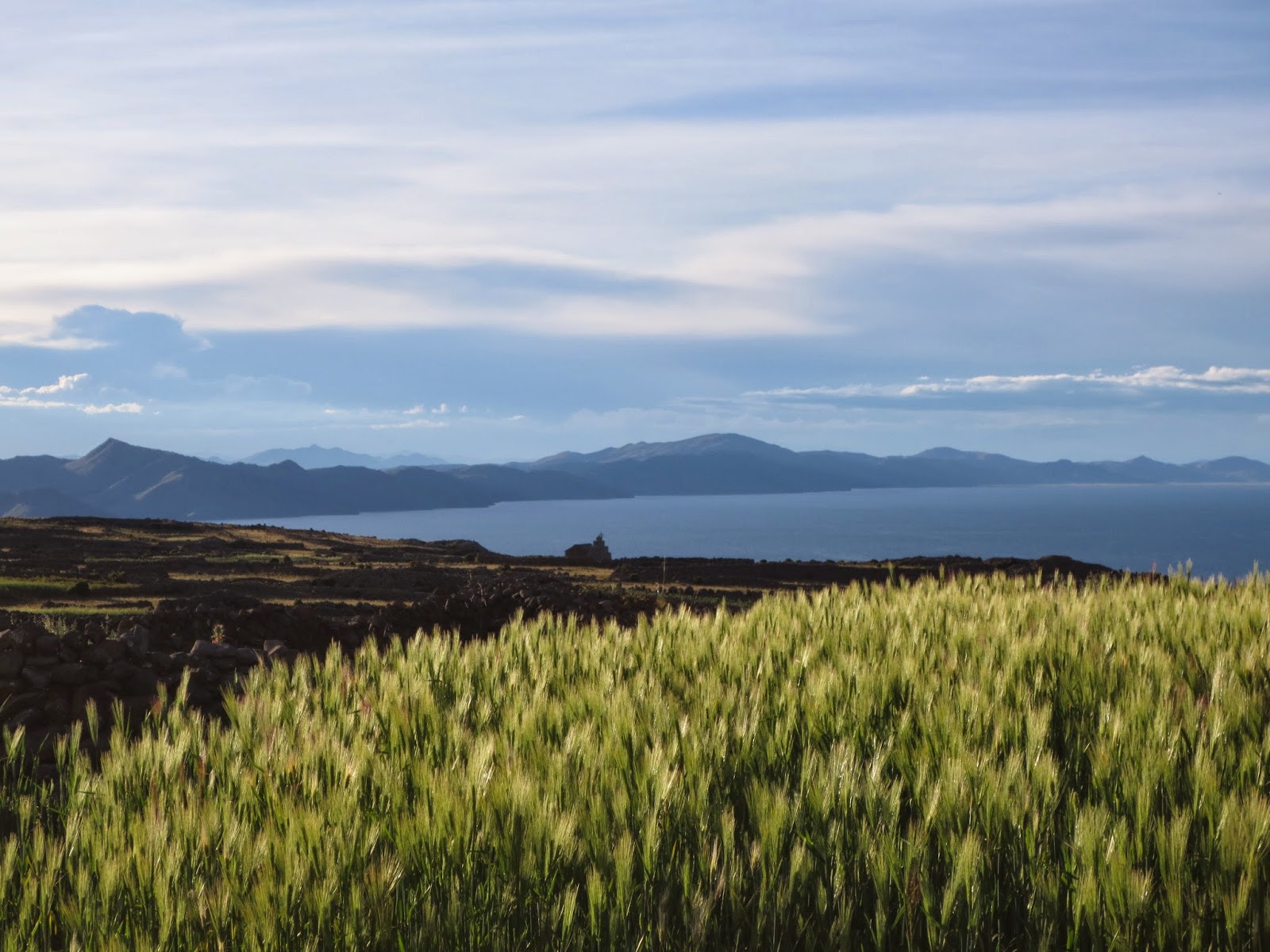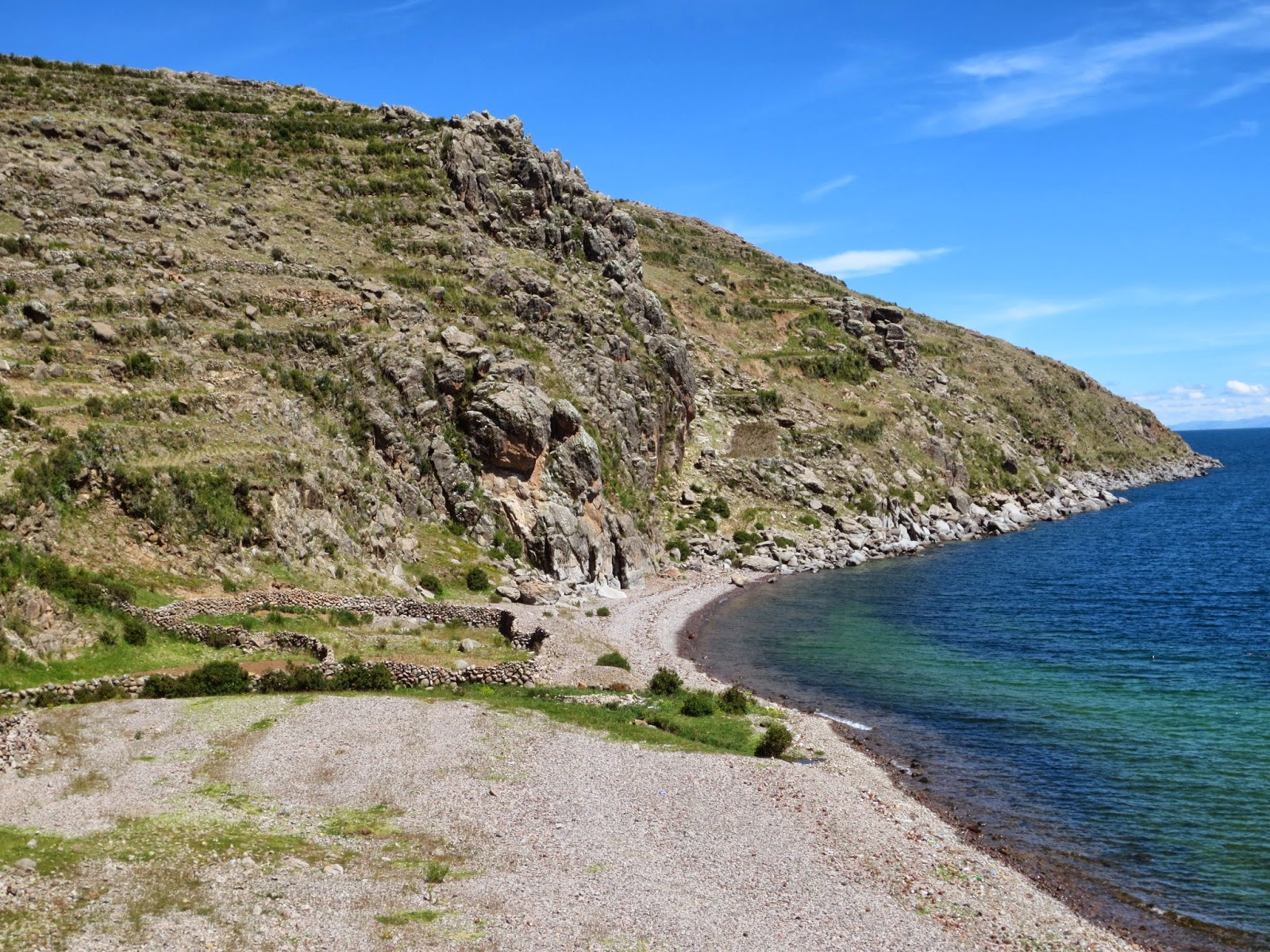Finally I have found a little bit of paradise here in Peru. Isla Amantani is beautiful, tranquil, clean, friendly, safe. There are no cars, no roads and supposedly no dogs, although I did hear one barking. The people of the island have a well-organized tourist homestay business -and some policies to make the island more appealing to tourists. For example, the homes are all adobe with corrugated metal roofs, painted terracotta colour which makes a big difference. There is electricity here, but it only seems to be used for water pumps, light and music. Cooking is done over a wood or dung fire or on a gas stove. No one seems to have a fridge.
Most of the island is farmed, with tidy terraced plots dating back to Inca times. They grow quinoa, wheat, barley, oka (tiny sweet potatoes), but no veg. There are a few fruits on vines, but most fruit and veg are brought from the mainland.
 |
| Burrow with quinoa |
Maude, Leonarda (from Amantani) and I arrived by boat
 |
| Our captain |
from Capachica to the main dock on the west side of the island. We walked from there, up and over and down to the east side, to the home of Leonarda's sister, Felicitas and her husband, Sebastian.
 |
| Detail of shawl which Sebastian embroidered by machine |
They were very welcoming and hospitable. We all stayed there one night, and I stayed a second night on my own to have a full day of serenity there.
The day we arrived was the last day of their Carnival celebration. One of their traditions is to chop down a tree on this day. It seems such a shame when trees are scarce even on the island. They decorate the tree days ahead of time, with streamers, balloons, even coloured blankets. On the day of sacrifice, the community gathers around the tree with music, dancing and drinking. We chose not to go to the chopping, but apparently they dance around the tree, swinging at the trunk with axes.
In the late afternoon, when the temperatures had cooled a little, we hiked up to Pachatata, Earth Father, where one has a spectacular 360 degree view of the lake, islands and shoreline, and in the distance, the snow-covered peaks of both Peru and Bolivia.
The whole time we were walking around the island and up to Pachatata, I was very impressed that Leonarda, who must be close to my age, carried a bundle, and spun alpaca yarn on a drop spindle as she climbed. She has a technique I haven't seen before in which she tosses the spindle behind her, and then gathers the barely spun yarn onto her fingers in a butterfly, finally winding it onto the spindle.
 |
| Felicitas me and Leonarda |
We had quinoa soup for a few of our meals, as well as oka, rice and potatoes, always followed by a nice mate (herbal tea). For breakfast we had pancakes, very firm and flat. I sprinkled a little sugar on mine because they were very plain.
The second day was particularly tranquil. After breakfast I walked to the edge of the cliffs overlooking the lake, and just sat, listening to the waves and the birds, and breathing in the fresh air.
Eventually I forced myself to explore a bit further. I wanted to find a stoney beach I had seen the previous day, because I really wanted to have a swim in Lake Titicaca. I walked along the cliffs and across some terraces and finally I was looking down on the beach.
Much to my dismay, I could see that it was littered with dozens of plastic bottles and cans and other flotsam which had washed up on shore. It didn't look very inviting, but I clambered down the cliffs anyhow. I chose a clear spot to sit on the smooth stones, and examined the beautiful colors and textures surrounding me.
I made a collection of the smallest samples I could find. I also discovered lots of broken terracotta pottery, with smooth edges from being tossed around in the lake for so long. Again I made a little collection. Perhaps they are not incredibly old, but maybe some of them are ancient!
The second morning, I took a boat from Amantani to Isla Taquile. Here I joined a tourist group because I had been warned about getting lost and having to fend for myself overnight. I enjoyed the company of five young women, all of whom were traveling independently, from Canada, U.S., Denmark, Germany and Brazil. We walked up and over the top of the island, stopping at a designated spot for a demonstration of local handiwork. The men of the island knit themselves very fine, tight hats, in the shape of a long toque with ear flaps. The single men wear a red and white hat, and do their best work to attract a wife. The hats of the married men are mostly red, with no white.
We also saw the use of a plant, called illmanke which is a natural detergent, to wash the sheep wool before dying it. Very effective.
We had lunch at that same spot, overlooking the lake from up high. It was excellent. First we had bread and salsa, then quinoa soup, and then the main dish, fried trout with rice and veg. Followed by mate. Apparently the trout is Canadian. It was introduced to the waters of Peru and has taken over the local species!
The boat ride back to Puno was about three hours, and very relaxing. The lake was calm, and the boat went quite slowly. Most of the time I sat on the roof with those young women. During the second half of the trip we could see a big thunder, lightning, rainstorm over Puno. It was spectacular from the distance, and cleared up before we got there.
Our final approach to Puno was through a channel in the totara reeds, which have created the floating islands. I am eager to visit those islands to see how it is possible to live in what seems such a precarious environment. More on that after my visit there.














No comments:
Post a Comment